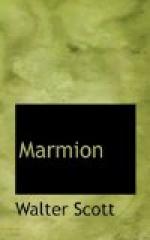lines 155-65. By the result of the battle of Austerlitz (December, 1805) Napoleon seemed advancing towards general victory. Prussia hastily patched up a dishonourable peace on terms inconsistent with very binding pledges, and the Russian minister at Paris compromised his country by yielding to humiliating proposals on the part of France. All this changed Fox’s view of the position, and he broke off the negotiations for peace which had been begun in accordance with a policy he had long advocated.
line 161. There is a probable reference here to Nelson’s action at the battle of the Baltic. He disregarded the signal for cessation of fighting given by Sir Hyde Parker, and ordered his own signal to be nailed to the mast.
line 176. Thessaly was noted for witchcraft. The scene of Virgil’s eighth Eclogue is laid in Thessaly as appropriate to the introduction of such machinery as enchantments, love-spells, &c. Cp. Horace, Epode v. 21, and Ode I. xxvii. 21:—
’Quae saga, quis
te solvere Thessalis
Magus venenis,
quis poterit deus?’
In his ‘Letters on Demonology and Witchcraft,’ Letter iii., Scott, obviously basing his information on Horace, writes thus:—’The classic mythology presented numerous points in which it readily coalesced with that of the Germans, Danes, and Northmen of a later period. They recognised the power of Erictho, Canidia, and other sorceresses, whose spells could perplex the course of the elements, intercept the influence of the sun, and prevent his beneficial operation upon the fruits of the earth; call down the moon from her appointed sphere, and disturb the original and destined course of nature by their words and charms, and the power of the evil spirits whom they evoked.’
line 181. Lees is properly pl. of lee (Fr.lie = dregs), the sediment or coarser parts of a liquid which settle at the bottom, but it has come to be used as a collective word without reference to a singular form. For phrase, cp. Macbeth, ii. 3. 96:—
’The wine of life
is drawn, and the mere lees
Is left this vault
to brag of.’
line 185. Cp. Byron’s ’Age of Bronze’:—
’But where are
they—the rivals!—a few feet
Of sullen earth
divide each winding-sheet.’
line 199. hearse, from Old Fr. herce = harrow, portcullis. In early English the word is used in the sense of ‘harrow’ and also of ‘triangle,’ in reference to the shape of the harrow. By-and-by it came to be used variously for ‘bier,’ ‘funeral carriage,’ ornamental canopy with lighted candles over the coffins of notable people during the funeral ceremony, the permanent framework over a tomb, and even the tomb itself. Cp. Spenser’s Shep. Cal., November Eclogue:—
’Dido, my deare,
alas! is dead,
Dead, and lyeth
wrapt in lead.
O
heavie herse!’
The gloss to this is, ‘Herse is the solemne obsequie in funeralles.’ Cp. also Ben Jonson’s ’Epitaph on the Countess of Pembroke’:—




